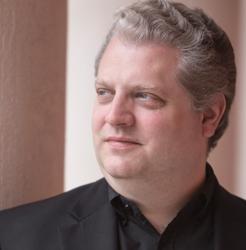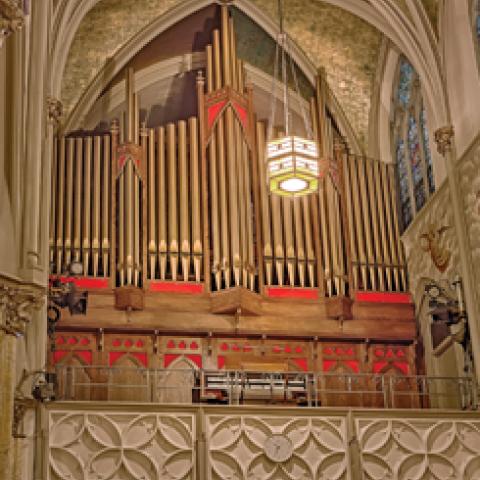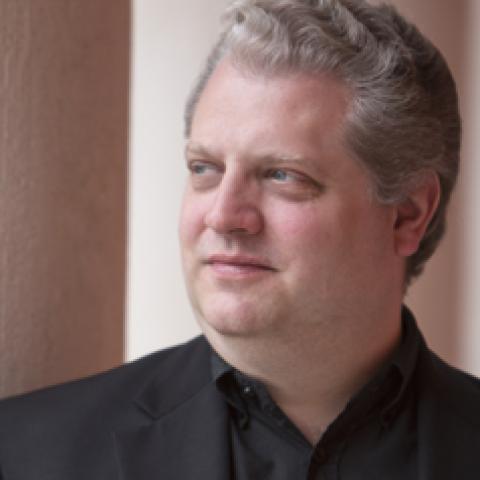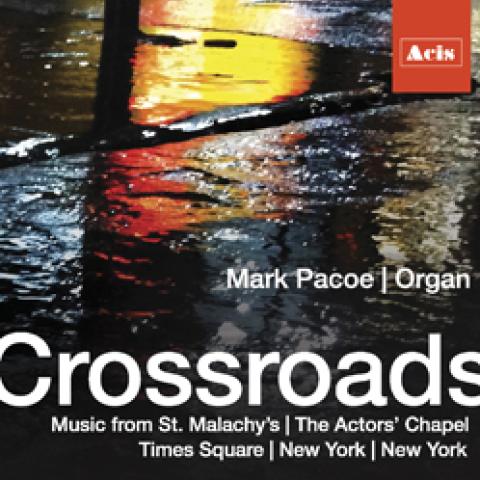An interview with Stephen Tharp appeared a decade ago in The Diapason (“A conversation with Stephen Tharp: Catching up with a well-traveled recitalist,” January 2004). At that time, Tharp’s discography included six recordings, and he had made over twenty intercontinental tours. Among the topics discussed were Tharp’s many concert tours, his advocacy of new music, and interest in transcriptions. In the decade since, Tharp has continued his travels and performances, and received many accolades. He presently resides in New York City, where he serves as associate director of music at the Church of Our Saviour. Stephen Tharp will be the featured performer at the closing recital of 2014’s American Guild of Organists national convention in Boston.
Joyce Robinson: Our previous interview’s title called you a “well-traveled recitalist,” and that seems truer than ever today. Tell us about your concert tours (and how you keep track of all those recitals!).
My grandfather, who was director of personnel management at Blue Cross/Blue Shield in Chicago for some 40-plus years, and also a lecturer at both Northwestern University and University of Chicago post-World War II, was a real business model for me. He was the ultimate paper hoarder, keeping track of all of his correspondence, lectures, and so forth, throughout his life. For better or worse, he taught me to keep a paper record of everything I’d accomplished.
Of course, I let go of a great deal with time, but, as far as concert programs go, I have saved one copy of everything I have ever played. Consequently, after 1,400 concerts, I am glad I can look back, trace them, and keep track—like keeping a diary. My 1300th solo recital was at St. Laurenskerk in Rotterdam, on their very large Marcussen organ, in November 2008. A few days later, in St. Martin, Dudelange, Luxembourg, was the concert that coincided with my Jeanne Demessieux Complete Organ Works CD set (Aeolus Recordings) “release party,” where the recording was officially made available to the public for the first time. It remains my largest recording project to date, which I will discuss more a little later. The recording led directly to a series of three concerts in October 2010 at the Cathedral of St. John the Divine in New York City, wherein I played the complete organ works of Demessieux.
On July 30, 2013, I performed my 1400th solo concert, for the organ festival in La Verna, Tuscany (some of which is up on YouTube). This is the place, on top of a mountain and a 90-minute drive from Florence, where Francis of Assisi spent his later years on land that was bequeathed to him. It is a picturesque spot surrounded by forests untouched for some 900 years; in the center is a basilica where there is a regular summer festival of organ concerts catering to an immense tourist crowd that packs the house for recitals starting at 9 p.m. (when the temperature cools down enough for a full church to be tolerable). A small group of friends and colleagues celebrated afterwards with a private meal that included regional wines.
What is awesome for the organ in central European culture is that festivals like this, well attended, grow on trees. In Germany alone, you could hit a series every weekend for two years without repeating yourself—funding in place, quite often new organs, and audiences that support its continuation. There seems something about Old World culture that’s founded in the deepest roots, centuries of traditions under them, that maintains a thriving life no matter what the come-and-go cultural shifts of any given generation—a kind of condensed richness around which you can build an entire life.
As for my own tours, 1,400 concerts means too many to name. Standouts include the Gewandhaus, Leipzig; the Igreja de Lapa in Porto, Portugal; Victoria Hall, Geneva; the Frauenkirche, Dresden (which was only recently reconstructed); the inaugural organ week of the new Seifert organ at the Cathedral in Speyer, Germany, with its 14-second acoustic—a whole new character for Alain’s Trois Danses; Ben van Oosten’s glorious festival in The Hague; twice at the Berlin Cathedral, with another concert set for summer 2015; Cologne Cathedral (with its 5,000 regular concertgoers during the summer Orgelfeierstunden, encouraged to bring their own lawn chairs if necessary and seat themselves in the aisles, which they do, going wild over a program of Guillou, Alain, Dupré, and Litaize); the summer festival at St. Bavo, Haarlem (there are no words for the experience of playing this organ); playing the de Grigny Messe on the Dom Bedos at Ste. Croix in Bordeaux, and so on. In addition to that, my one and only action-packed trip without jetlag adjustment, over six days, for concerts in St. Petersburg, Moscow, and Riga. Twice to Hong Kong, twice to Korea, twice to Australia. Every memorable moment outside the box would take a book. But connect all the dots over time and it’s the richest and most diverse menu of experiences I could ever have imagined. And as an American, it is seeing the forest from outside the trees, in spades, and that has determined a great deal for me.
You’ve also been busy with recordings. Would you summarize these, and tell us about your experiences making them?
This is a discussion of but a few of my projects. Ultimately, audio and video recordings are one’s most powerful tools. How one can spread the word on Facebook, iTunes, or YouTube puts global exposure at your fingertips, which is wonderful. Listening as a child to LPs of many organs, I often fantasized about getting to these instruments one day, either to perform on them or record them myself. One of my greatest battery chargers, the kind that continues to inspire in the long term, has been recording a number of these landmark instruments, both for JAV Recordings and the Aeolus label in Germany.
The first opportunity like this was St. Sulpice, Paris, where I recorded in October 2001, a somewhat nervous traveler given the horrific events of September 11 the month before—and amplified by a flight over to Paris on a plane that was mostly empty. In 2005 I was back in St. Sulpice for two more projects. A large choir, comprising several groups, was assembled to record the Widor Mass, op. 36, for choir and two organs (main and choir organ), which was never before recorded in St. Sulpice. With Daniel Roth at the grand orgue, Mark Dwyer and I played musical benches with the orgue de choeur in the front of the church. In the two days that followed that project, I had the great pleasure of recording Dupré’s Le Chemin de la Croix there. Dupré recorded this years before in St. Sulpice on LP, which went out of print. So, my recording is the only one available of this entire work on the organ most associated with the composer.
In the summer/early fall of 2008 I made two more recordings for JAV within a month of each other, which were released at different times. One is my organ adaptation of J. S. Bach’s Goldberg Variations on Paul Fritts’s stunning magnum opus instrument at St. Joseph’s Cathedral, Columbus, Ohio, and the other a mixed repertoire recording on the Christian Müller organ of St. Bavo, Haarlem, the Netherlands. My first experience with this famous organ was as a student when, at age 20, I spent three weeks at the Haarlem International Organ Academy as the result of a generous scholarship from Illinois College. That experience was life-changing in that it turned my thinking upside down and, consequently, permanently re-directed the way I would conceive performance as it is informed by music history and aesthetics, standards that remain in place to this day. I can’t fully express how thankful I am that this was an experience I had at a young age, when these influences had the chance to be the most powerful.
On this side of the pond is the first commercial recording of the Casavant organ Opus 3837 at the Brick Presbyterian Church in Manhattan. This instrument, a cooperative design between director of music Keith Tóth and Jean-Louis Coignet, is a masterpiece. A synthesis between the French symphonic and American orchestral, the organ covers music from Jongen to Tournemire to Hakim to Guilmant, in a warm acoustic environment. There is also my Organ Classics from Saint Patrick Cathedral in New York City—all somewhat lighter fare, some organ solo, some organ plus trumpet, aside from a few heftier pieces by Cook, Vierne, and Widor. It was a great pleasure to have been able to make these two recordings.
All of my commercial CD releases from St. Sulpice thus far are on JAV, and all engineered by the outstanding Christoph Frommen, who also owns the Aeolus label in Germany. It was with Frommen, and for Aeolus, that I embarked upon my biggest recording project to date: The Complete Organ Works of Jeanne Demessieux. I had played much of her music starting as early as my college years, but to document all of her organ solo works on recording was an exciting and challenging prospect. Too many stereotypes were also floating around about this music: that it was a language worth little more than an extension of Dupré’s harmonic idiom, more cerebral than communicative, and not worth the effort. I sought to prove this very wrong.
At the time of the recording, several pieces remained unpublished, and so Chris Frommen and I sought copies of these in manuscript form from Pierre Labric, one of Demessieux’s more famous students, who generously shared the scores with us for this project. These are, specifically, Nativité, Andante, and the Répons (the one for Easter being the only score from the set previously published), now printed by Delatour in France.
We needed an electric-action organ for certain pieces, most importantly the treacherous Six Études, so some of the recording was done on the Stahlhuth/Jann instrument at the Church of St. Martin, Dudelange, Luxembourg, an organ of great color and strength. For the remainder of the release, we chose the great Cavaillé-Coll organ at St. Ouen, Rouen, France, an instrument closely associated with Demessieux’s life. This is such a splendid oeuvre that was too long overlooked. If you don’t know the music, investigate it.
It is with Aeolus that I will release my next recording, the Symphonies 5 and 6 of Louis Vierne. Symphonies 1–4 are now available with Daniel Roth, and my release will complete the set, hopefully later this year. All were recorded again at St. Sulpice.
One additional recording must be mentioned, as it appears as a single track on iTunes and is not part of any CD. In September 2010, as a part of one of Michael Barone’s Pipedreams Live! concerts, I played the world premiere of a work I’d commissioned for the occasion from George Baker, Variations on ‘Rouen.’ It is also composed in memory of Jehan Alain, and so there are harmonic and motivic nods in that direction, very much on purpose. That first performance was played at the Meyerson Symphony Center, Dallas; my recording of the piece, made as well at St. Sulpice, is what is available on iTunes. There is also a YouTube concert video of my live performance of it at the St. Louis Cathedral Basilica in Missouri from the summer of 2013.
You are also a composer and arranger, creating both transcriptions and original compositions. Are any of these published? Do you have any plans for future works?
I have only one published organ work, my Easter Fanfares, composed in 2006 as the result of a commission from Cologne Cathedral in Germany. Two new high-pressure en chamade Tuba ranks had been added to the instrument at the west end of the cathedral, which they wanted to play for the first time at Easter in 2006. My work was composed to be the postlude for that occasion. It is structured, at surface level, like an improvised sortie with the architecture of a written composition, with all melodic and motivic material throughout derived from only two sources: Ite Missa est, Alleluia, the dismissal at the conclusion of the Mass, and the Easter sequence Victimae Paschali Laudes. The piece is dedicated to the Cologne Cathedral organist Winfried Bönig, and is published in a collection of organ music specifically written for the Cologne Cathedral organ called Cologne Fanfares. It is published by Butz Musikverlag of Bonn. There is a JAV YouTube video of me playing the work at St. Patrick’s Cathedral in Manhattan, made a few years ago.
My only other fairly recent solo organ work was occasion-specific, my Disney’s Trumpets, written for the organ at the Walt Disney Hall in Los Angeles, where I premiered it in concert in March 2011. It is a short, agitato fanfare designed to highlight the various powerful reed stops of this particular instrument, heard both separately by division and, at times, altogether. I kept the unique visual design of the façade in mind. In musical terms, this is reflected in short riffs, which appear rapidly, flinging gestures into many directions at will. And as with the organ’s façade, which appears random to the eye amidst an underlying cohesive structure, so is true in this work, where an overall architecture gives proportion to what seems irregular. As an added layer of tongue-and-cheek, I used as the model for the riffs a motive from a song by David Bowie, of all things. (I don’t remember the name anymore.) I have only played Disney’s Trumpets that one time.
I also have an ongoing list of organ transcriptions, which I’m getting to little by little. Those are premiered here and there from time to time; Chopin, Dukas, Stravinsky, Bartók, Mussorgsky, Liszt. I have also toured quite a bit with David Briggs’s colorful transcription of Ravel’s Daphnis et Chloé and two rather demanding organ adaptations by a gifted Italian colleague, Eugenio Fagiani, namely J. S. Bach’s Brandenburg Concerto No. 3 and Ravel’s La Valse.
You have received several awards in recent years. Tell us about those.
There are two particular awards about which I feel especially honored. One is the 2011 International Performer of the Year award from the New York City chapter of the American Guild of Organists, the only award of its kind specifically for organists from any professional music guild in the United States. It is a recognition of long-standing accomplishment whose list of recipients is truly global, and I tie with Dame Gillian Weir for the youngest in the award’s history (received, respectively, at the same age in our early 40s). The other is the Preis der deutschen Schallplattenkritik, Germany’s highest critic’s award for recordings, which I received for The Complete Organ Works of Jeanne Demessieux release on Aeolus. Imagine some 140 judges looking at an assortment of releases and ripping apart everything from sound quality to performance to graphic design to music notes scholarship. This is the prize. The recipients are chosen under great scrutiny, more so than voted for (and there is a big difference). It is, for me subjectively, the ultimate compliment. Other recipients at that time include the Philadelphia Orchestra, Marc-André Hamelin, and Cecilia Bartoli.
Beyond your solo career, you have also worked as a church musician. Are you presently doing so?
In September 2013 I was offered the position of associate director of music and organist at the Church of Our Saviour (Roman Catholic) in Manhattan by the newly appointed music director and organist, Paul Murray, a long-time friend and colleague in the city with whom I have collaborated on many previous occasions. Ironically, it was in this very church that my wife Lena and I had our son Adrian (born January 5, 2013) baptized. This music program embodies high standards of choral singing—we have an all-professional choir—use of chant, a rich palette of choral and organ repertoire, and no-nonsense liturgical organ improvisation, something I was not doing in New York City since my days at St. Patrick’s Cathedral. The mission statement of the church has been beautifully summarized by Mr. Murray as follows:
In the Constitution on the Sacred Liturgy of the Second Vatican Council, it was made clear that the Church’s musical heritage, namely chant and polyphony, was to be preserved. At the Church of Our Saviour in New York City, it is my goal to build a liturgical music program that is in concurrence with the admonition of the Second Vatican Council, by developing a professional music program offering music of the highest caliber to the Greater Glory of God.
Paul and I have a great rapport as professional colleagues, devoid of the drama that all too often accompanies working relationships. In this regard, I’ve struck gold. The church is also very supportive of my travels. Everything about this position is a match, the kind one hopes to find but rarely does. It is a special centering for me that provides a constant in my artistic life as other things continue in different directions.
I must also make mention of post-Easter April 2008, when I was asked to be the official organist for the New York City visit of His Holiness Pope Benedict XVI. I was contacted by the current director of music at St. Patrick’s Cathedral, Jennifer Pascual, who was in charge of music for all events for the Pope’s visit. The organist at the cathedral had been taken ill, and I was asked to cover all televised events from St. Joseph’s Roman Catholic Church in Yorkville (in Manhattan), St. Patrick’s Cathedral, and, yes, Yankee Stadium, which took place outdoors. I was struck primarily with how this church leader in his 80s, not some young pop star, captivated these massive gatherings with an energy that was palpable. Music for each of the three occasions was different, involving soloists, choirs, and instrumental ensembles, rehearsals for all of which occurred in under two weeks. It was quite moving to be in the center of the energy that radiated from these huge events. And my days at St. Patrick’s Cathedral in the mid-1990s had prepared me for live television, which is always exhilarating.
What are your thoughts about the future?
Becoming the father of a little boy who is now 1-1/2 years old has become the ultimate filter. My shifts in priorities have been herculean, in a way that a parent understands. I am very sensitive to the passage of time one doesn’t see again, so there is this intolerance for the irrelevant, the counter-productive and the trivial.
The most important thing for me to remember is why I have always done what I do, as that unshakably justifies how I must continue. It is critical for me to remember that I was never media-constructed at a young age. In fact, that approach in this country during my 20s, under management, completely failed. I have, however, taken decades to build where I am, and am one who is given the respect on a global platform that I probably sought above all else. It’s an Old School approach to achievement—and it stems from the kind of teaching I had—the kind that leaves you a library of references, not just a membership, and that you don’t accomplish overnight. It must be earned.
This all underscores one aspect of my musical life that has become even more pronounced. I consider myself a very serious artist, not an entertainer, one who believes that an audience knows the difference between putting before them a substantial product and just celebrity. If what you speak reaches people profoundly, they remember not only you as the vehicle but the statement, the music itself, and musical memories that matter. You see, this is what will actually save our instrument. Popularity alone is not enough. Actually moving an audience is vital, as this instigates a curiosity for more, which has direct impact on literacy, not merely fascination. It is not possible to produce book after book without addressing the literacy of your readers and then claim you have “saved the book.” There is a big difference between selling an audience tickets and keeping them there. That said, every teacher has to make decisions: one cannot build rockets by continuing to play with blocks. And if nobody curates the collection, what will all of the newly schooled have to hear beyond Concerts 101?
It is no great secret that I have a mostly European career. My own passion for the lineage of such long-rooted, historically aware and layered culture seems to be a marriage with the demand for it from the large (and multi-aged) audiences that continue to want programs of real meat and substance. I feel that I am most inspired engaging an environment wherein, no matter what other globalization invades, the baby isn’t simply discarded with the bathwater. This will continue as my direction for the future, regardless of what else happens. It’s taken me years to evolve to this point, but this article documents part of the journey.
Stephen Tharp's Discography
Naxos Recordings 8.553583
Ethereal Recordings 108
Ethereal Recordings 104
Capstone Records 8679
Ethereal Recordings 123
JAV Recordings 130
JAV Recordings 138
JAV Recordings 161
JAV Recordings 160
JAV Recordings 162
Aeolus Recordings 10561
JAV Recordings 178
JAV Recordings 172
JAV Recordings 185
JAV Recordings 5163
Christopher Berry (cond.); Stephen Tharp (org.); the Seminary Choir of the Pontifical North American College, Vatican City State
Duruflé Messe “cum Jubilo”; sung chants; organ improvisations
JAV Recordings 181
Christopher Hyde (cond.); Camille Haedt-Goussu (cond.); Daniel Roth (Grand Orgue); Stephen Tharp (Orgue du Choeur); Mark Dwyer (Orgue du Choeur); Choeur Darius Milhaud; Ensemble Dodecamen
Widor Mass, Op. 36 plus motets; choir/organ works by Bellenot and Lefébure-Wély; organ improvisations by Daniel Roth
Recorded at St. Sulpice, Paris, France
JAV Recordings 158
Richard Proulx (cond.); Stephen Tharp (org.); The Cathedral Singers
Recorded at St. Luke’s Church, Evanston, Illinois
GIA Publications, Chicago
Maxine Thévenot (cond. and org.); Stephen Tharp (org.)
The Choirs of the Cathedral of St. John, Albuquerque, New Mexico
Raven OAR-926
Maxine Thévenot (cond. and org.); Stephen Tharp (org.); Edmund Connoly (org.)
The Choirs of the Cathedral of St. John, Albuquerque, New Mexico
Raven OAR-954
Maxine Thévenot (cond. and org.); Stephen Tharp (org.); Edmund Connoly (org.)
The Choirs of the Cathedral of St. John, Albuquerque, New Mexico
Raven OAR-955





